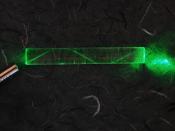It is based on the principle of total internal reflection. This means light that is travelling thru the core hits the outside surface at an angle of incidence greater than the critical angle for that material, so that all the light is reflected back into the fibre without loss. To stop light scattering the core is clad with a glass of a much lower refractive index.
Fibre optics is used in many different areas of society.
In medicine it takes the form of an endoscope. This is an instrument that can be inserted into a patient via the mouth to look inside. In order to get an image light is shone down the endoscope and reflected back up the bundle of fibres and viewed through an eyepiece by the endoscopist. Originally endoscopes were only used for diagnosis. However they can now be used to perform procedures such as biopsies and laser therapy.
Most importantly fibre optics has made many advances in telecommunications. Optical Cables are constantly replacing electrical (coaxial cables which are made of copper). The Advantage of optical over copper cables are they can carry higher amounts of information and faster, undersea optical cables that have a diameter the size of a golf ball can carry 62,500 pages a second or 200,000 telephone calls at once. Also the light can travel a longer distance until repeaters are used. Fibre optic repeaters are usually placed 100km apart compared to 1.5 km for electrical systems.


